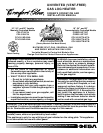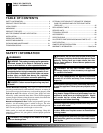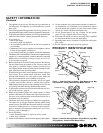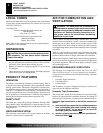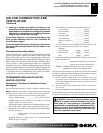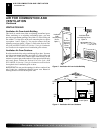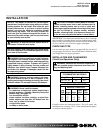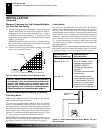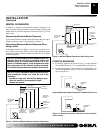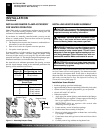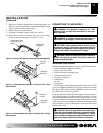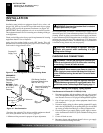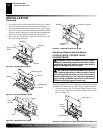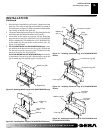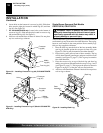
111160-01A
For more information, visit www.desatech.com
For more information, visit www.desatech.com
4
AIR FOR COMBUSTION AND
VENTILATION
Today’s homes are built more energy efficient than ever. New
materials, increased insulation, and new construction methods help
reduce heat loss in homes. Home owners weather strip and caulk
around windows and doors to keep the cold air out and the warm air
in. During heating months, home owners want their homes as airtight
as possible.
While it is good to make your home energy efficient, your home
needs to breathe. Fresh air must enter your home. All fuel-burning
appliances need fresh air for proper combustion and ventilation.
Exhaust fans, fireplaces, clothes dryers, and fuel burning appliances
draw air from the house to operate. You must provide adequate fresh
air for these appliances. This will insure proper venting of vented
fuel-burning appliances.
PROVIDING ADEQUATE VENTILATION
The following are excerpts from National Fuel Gas Code, ANSI
Z223.1/NFPA 54, Section 5.3, Air for Combustion and Ventilation.
All spaces in homes fall into one of the three following ventilation
classifications:
1. Unusually Tight Construction
2. Unconfined Space
3. Confined Space
The information on pages 4 through 6 will help you classify your
space and provide adequate ventilation.
Unusually Tight Construction
The air that leaks around doors and windows may provide enough
fresh air for combustion and ventilation. However, in buildings of
unusually tight construction, you must provide additional fresh air.
Unusually tight construction is defined as construction
where:
a. walls and ceilings exposed to the outside atmosphere
have a continuous water vapor retarder with a rating
of one perm (6x10
-11
kg per pa-sec-m
2
) or less with
openings gasketed or sealed
and
b. weather stripping has been added on openable win-
dows and doors
and
WARNING: This heater shall not be installed in a
confined space or unusually tight construction unless
provisions are provided for adequate combustion and
ventilation air. Read the following instructions to in-
sure proper fresh air for this and other fuel-burning
appliances in your home.
LOCAL CODES
Install and use heater with care. Follow all local codes. In the absence
of local codes, use the latest edition of The National Fuel Gas Code,
ANSI Z223.1/NFPA 54*.
*Available from:
American National Standards Institute, Inc.
1430 Broadway
New York, NY 10018
National Fire Protection Association, Inc.
Batterymarch Park
Quincy, MA 02269
Note:
Where listed vented decorative logs are required, thermo-
stat operation is not permitted.
OPERATION
This heater is clean burning. It requires no outside venting. There is
no heat loss out a vent or up a chimney. Heat is generated by realistic
dancing, yellow flames. This heater is designed for vent-free opera-
tion with flue damper closed. It has been tested and approved to
ANSI Z21.11.2 standard for unvented heaters. State and local codes
in some areas prohibit the use of vent-free heaters. This heater may
also be operated as a vented decorative (ANSI Z21.60) product by
opening the flue damper (non-thermostat operation only).
SAFETY PILOT
This heater has a pilot with an Oxygen Depletion Sensing (ODS)
safety shutoff system. The ODS/pilot is a required feature for vent-
free room heaters. The ODS/pilot shuts off the heater if there is not
enough fresh air.
PIEZO IGNITION SYSTEM
This heater has a piezo ignitor. This system requires no matches,
batteries, or other sources to light heater.
PRODUCT FEATURES
UNPACKING
1. Remove logs and heater base assembly from carton.
Note:
Do
not pick up heater base assembly by burners. This could dam-
age heater. Always handle base assembly by grate.
2. Remove all protective packaging applied to logs and heater
for shipment.
3. Check all items for any shipping damage. If damaged, promptly
inform dealer where you bought heater.
CAUTION: Do not remove the data plates from the
grate assembly. The data plates contain important
product information.
LOCAL CODES
UNPACKING
PRODUCT FEATURES
AIR FOR COMBUSTION AND VENTILATION
Providing Adequate Ventilation



